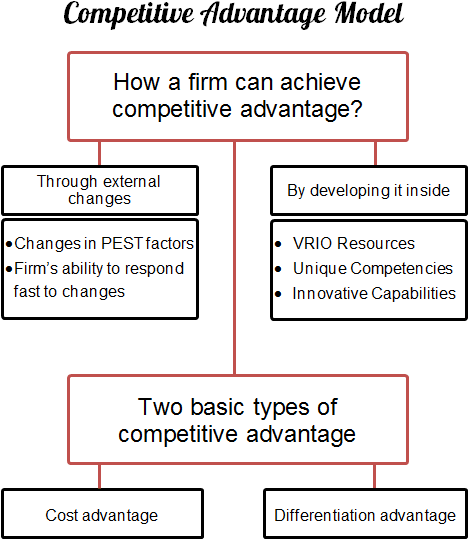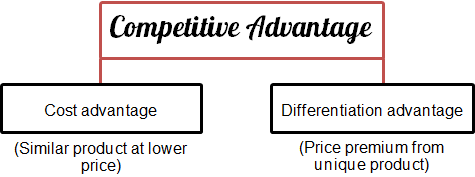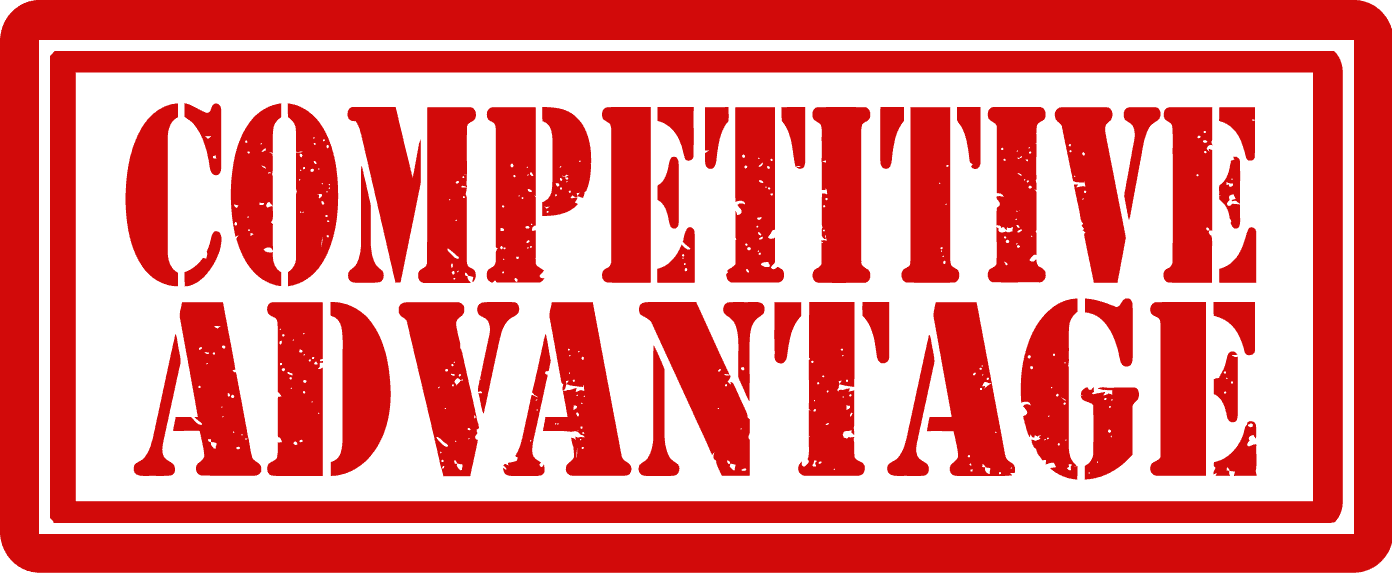Definition
Competitive advantage means superior performance relative to other competitors in the same industry or superior performance relative to the industry average.[1]
What is competitive advantage?
There is no one answer about what is competitive advantage or one way to measure it, and for the right reason. Nearly everything can be considered as competitive edge, e.g. higher profit margin, greater return on assets, valuable resource such as brand reputation or unique competence in producing jet engines. Every company must have at least one advantage to successfully compete in the market. If a company can’t identify one or just doesn’t possess it, competitors soon outperform it and force the business to leave the market.
There are many ways to achieve the advantage but only two basic types of it: cost or differentiation advantage. A company that is able to achieve superiority in cost or differentiation is able to offer consumers the products at lower costs or with higher degree of differentiation and most importantly, is able to compete with its rivals.
An organization that is capable of outperforming its competitors over a long period of time has sustainable competitive advantage.
The following diagram illustrates the basic competitive advantage model, which is explained below in the article:

How a company can achieve it?
An organization can achieve an edge over its competitors in the following two ways:
- Through external changes. When PEST factors change, many opportunities can appear that, if seized upon, could provide many benefits for an organization. A company can also gain an upper hand over its competitors when its capable to respond to external changes faster than other organizations.
- By developing them inside the company. A firm can achieve cost or differentiation advantage when it develops VRIO resources, unique competences or through innovative processes and products.
External Changes
Changes in PEST factors. PEST stands for political, economic, socio-cultural and technological factors that affect firm’s external environment. When these factors change many opportunities arise that can be exploited by an organization to achieve superiority over its rivals. For example, new superior machinery, which is manufactured and sold only in South Korea, would result in lower production costs for Korean companies and they would gain cost advantage against competitors in a global environment. Changes in consumer demand, such as trend for eating more healthy food, can be used to gain at least temporary differentiation advantage if a company would opt to sell mainly healthy food products while competitors wouldn’t. For example, Subway and KFC.
If opportunities appear due to changes in external environment why not all companies are able to profit from that? It’s simple, companies have different resources, competences and capabilities and are differently affected by industry or macro environment changes.
Company’s ability to respond fast to changes. The advantage can also be gained when a company is the first one to exploit the external change. Otherwise, if a company is slow to respond to changes it may never benefit from the arising opportunities.
Internal Environment
VRIO resources. A company that possesses VRIO (valuable, rare, hard to imitate and organized) resources has an edge over its competitors due to superiority of such resources. If one company has gained VRIO resource, no other company can acquire it (at least temporarily). The following resources have VRIO attributes:
- Intellectual property (patents, copyrights, trademarks)
- Brand equity
- Culture
- Know-how
- Reputation
Unique competences. Competence is an ability to perform tasks successfully and is a cluster of related skills, knowledge, capabilities and processes. A company that has developed a competence in producing miniaturized electronics would get at least temporary advantage as other companies would find it very hard to replicate the processes, skills, knowledge and capabilities needed for that competence.
Innovative capabilities. Most often, a company gains superiority through innovation. Innovative products, processes or new business models provide strong competitive edge due to the first mover advantage. For example, Apple’s introduction of tablets or its business model combining mp3 device and iTunes online music store.
Two basic types
M. Porter has identified 2 basic types of competitive advantage: cost and differentiation advantage.

Cost advantage. Porter argued that a company could achieve superior performance by producing similar quality products or services but at lower costs. In this case, company sells products at the same price as competitors but reaps higher profit margins because of lower production costs. The company that tries to achieve cost advantage (like Amazon.com) is pursuing cost leadership strategy. Higher profit margins lead to further price reductions, more investments in process innovation and ultimately greater value for customers.
Differentiation advantage. Differentiation advantage is achieved by offering unique products and services and charging premium price for that. Differentiation strategy is used in this situation and company positions itself more on branding, advertising, design, quality and new product development (like Apple Inc. or even Starbucks) rather than efficiency, outsourcing or process innovation. Customers are willing to pay higher price only for unique features and the best quality.
The cost leadership and differentiation strategies are not the only strategies used to gain competitive advantage. Innovation strategy is used to develop new or better products, processes or business models that grant competitive edge over competitors.
Sources
- Barney, B.J. (1995). Looking inside for Comp. Adv. Academy of Management Executive, Vol. 9 (4), pp.49-61. Available at: http://www.jstor.org/stable/4165288?seq=1

